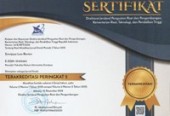The Role of Human Rights and Customary Law to Prevent Early Childhood Marriage in Indonesia
Abstract
Keywords
Full Text:
PDFReferences
Althabhawi, Nabeel Mahdi, Zinatul Ashiqin Zainol, and Parviz Bagherib. “Society 5.0: A New Challenge to Legal Norms.” Sriwijaya Law Review 6, no. 1 (2022): 41–54. https://doi.org/10.28946/slrev.Vol6.Iss1.1415.pp41-54.
Dariyo, Agoes, Mia Hadiati, and R Rahaditya. “Pemahaman Undang-Undang Perkawinan Terhadap Penundaan Perkawinan Usia Dini Di Indonesia.” Journal An-Nafs: Kajian Penelitian Psikologi 5, no. 1 (2020): 25–37.
Darmi, Rosmi. “Implementasi Konvensi Hak Anak Terkait Dengan Perlindungan Anak Yang Berhadapan Dengan Proses Hukum (Implementation of Children Rights Convention Re-lated to Children Protection Against the Law).” Jurnal Penelitian Hukum De Jure 16, no. 4 (2017): 439–50.
Deane, Tameshnie. “Marrying Young: Limiting the Impact of a Crisis on the High Prevalence of Child Marriages in Niger.” Laws 10, no. 3 (2021): 61. https://doi.org/10.3390/laws10030061.
Fuentes, Alejandro, and Marina Vannelli. “Expanding the Protection of Children’s Rights to-wards a Dignified Life: The Emerging Jurisprudential Developments in the Americas.” Laws 10, no. 4 (2021): 84. https://doi.org/10.3390/laws10040084.
Gillett-Swan, Jenna, and Lisa van Leent. “Exploring the Intersections of the Convention on the Rights of the Child General Principles and Diverse Sexes, Genders and Sexualities in Education.” Social Sciences 8, no. 9 (2019): 260. https://doi.org/10.3390/socsci8090260.
Handayani, Sri, Syarifah Nuraini, and Rozana Ika Agustiya. “Faktor-Faktor Penyebab Per-nikahan Dini Di Beberapa Etnis Indonesia.” Buletin Penelitian Sistem Kesehatan 24, no. 4 (2021): 265–74. https://doi.org/10.22435/hsr.v24i4.4619.
Humanium. “Right to Life: Understanding Children’s Right to Life,” n.d. https://www.humanium.org/en/life/.
Jayeola, Damilola Ayotola. Gender Equality and the South African Customary Law: Issues of Ukuthwala and Its Links to Child Marriage. University of Johannesburg (South Africa), 2018.
Kaviani Johnson, Afrooz, and Julia Sloth-Nielsen. “Safeguarding Children in the Developing World—Beyond Intra-Organisational Policy and Self-Regulation.” Social Sciences 9, no. 6 (2020): 98. https://doi.org/10.3390/socsci9060098.
kemenpppa. “Kemen PPPA: Cegah Perkawinan Anak Mulai Dari Keluarga Dan Masyarkat,” n.d. https://www.kemenpppa.go.id/index.php/page/read/29/3058/kemen-pppa-cegah-perkawinan-anak-mulai-dari-keluarga-dan-masyarkat.
Kinasih, Sri Endah, Toetik Koesbardiati, and Siti Mas’udah. “Women’s Reproductive Rights Under Marriage Contract.” Journal of International Women’s Studies 20, no. 9 (2019): 132–44.
Lee‐Rife, Susan, Anju Malhotra, Ann Warner, and Allison McGonagle Glinski. “What Works to Prevent Child Marriage: A Review of the Evidence.” Studies in Family Planning 43, no. 4 (2012): 287–303.
Muntamah, Ana Latifatul, Dian Latifiani, and Ridwan Arifin. “Pernikahan Dini Di Indonesia: Faktor Dan Peran Pemerintah (Perspektif Penegakan Dan Perlindungan Hukum Bagi Anak).” Widya Yuridika: Jurnal Hukum 2, no. 1 (2019): 1–12. https://doi.org/10.31328/wy.v2i1.823.
NM, Naseera, and Moly Kuruvilla. “The Sexual Politics of the Manusmriti: A Critical Analy-sis with Sexual and Reproductive Health Rights Perspectives.” Journal of International Women’s Studies 23, no. 6 (2022): 21.
Nour, Nawal M. “Child Marriage: A Silent Health and Human Rights Issue.” Reviews in Ob-stetrics and Gynecology 2, no. 1 (2009): 51.
Prameswari, Zendy Wulan Ayu Widhi. “Ratifikasi Konvensi Tentang Hak-Hak Anak Dalam Sistem Peraturan Perundang-Undangan Di Indonesia.” Yuridika 32, no. 1 (2017): 167–88. https://doi.org/10.20473/ydk.v32i1.4842.
Ramadhan, Ardito. “Laporan Kasus Kekerasan Terhadap Anak Dan Perempuan Meningkat 3 Tahun Terakhir,” n.d. https://nasional.kompas.com/read/2022/01/20/12435801/laporan-kasus-kekerasan-terhadap-anak-dan-perempuan-meningkat-3-tahun.
Riekkinen, Mariya. “Public Participation Of Children: Foundations And A Review Of Russian Legal Practices Under The Convention On The Rights Of The Child.” Baltic Journal of Law & Politics 2, no. 2 (2009): 103–38. https://doi.org/10.2478/v10076-009-0013-9.
Sahlberg, Sofia, Katarina Karlsson, and Laura Darcy. “Children’s Rights as Law in Sweden–every Health‐care Encounter Needs to Meet the Child’s Needs.” Health Expectations 23, no. 4 (2020): 860–69.
Salmah, Syarifah. “Pernikahan Dini Ditinjau Dari Sudut Pandang Sosial Dan Pendidikan.” Al-Hiwar: Jurnal Ilmu Dan Teknik Dakwah 4, no. 6 (2017).
Sandland, Ralph. “A Clash of Conventions?: Participation, Power and the Rights of Disabled Children.” Social Inclusion 5, no. 3 (2017): 93–103. https://doi.org/10.17645/si.v5i3.955.
Shariff, Salahudin Hidayat. “The Application of the Best Interests of the Child Principle as a Criterion for Fulfilling Malaysia’s Convention on the Rights of the Child Obligations: A Comparative Study Between Malaysia’s Child Act 2001 and the English Children’s Act 1989 Including the Common Law and Shari’ah Law Applications in the Respective Ju-risdictions.” University of Kent, 2018.
Svanemyr, Joar, Venkatraman Chandra-Mouli, Charlotte Sigurdson Christiansen, and Michael Mbizvo. “Preventing Child Marriages: First International Day of the Girl Child ‘My Life, My Right, End Child Marriage.’” Reproductive Health 9, no. 1 (2012): 1–3. https://doi.org/10.1186/1742-4755-9-31.
UN. “Resolution of the United Nations General Assembly on Transforming Our World: The 2030 Agenda for Sustainable Development,” n.d. https://sdgs.un.org/2030agenda.
UNICEF. “Child Marriage: Child Marriage Threatens the Lives, Well-Being and Futures of Girls around the World.” Accessed May 24, 2022. https://www.unicef.org/protection/child-marriage.
———. “Child Rights and Why They Matter: Every Right, for Every Child,” n.d. https://www.unicef.org/child-rights-convention/child-rights-why-they-matter.
———. “Violence against Children,” n.d. https://data.unicef.org/topic/child-protection/violence/.
———. “What Is the Convention on the Rights of the Child?: Child Rights We Should All Know,” n.d. https://www.unicef.org/thailand/what-is-crc.
Videlia Putsanra, Dipna. “Kasus Aisha Weddings Dan Apa Bahayanya Nikah Anak Di Bawah Umur.” Tirto, 2021. https://tirto.id/kasus-aisha-weddings-dan-apa-bahaya-nikah-anak-di-bawah-umur-gacg.
Widyastari, Dyah Anantalia, Pimonpan Isarabhakdi, Patama Vapattanawong, and Marc Völk-er. “Rethinking Early Childbearing in Indonesia: Is It Preceded by a Premarital First Birth?” International Journal of Adolescent Medicine and Health 34, no. 1 (2022). https://doi.org/10.1515/ijamh-2019-0055.
DOI: http://dx.doi.org/10.28946/slrev.Vol6.Iss2.1885.pp268-285
Refbacks
- There are currently no refbacks.

Sriwijaya Law Review (SLRev) ISSN: 2541-5298 | e-ISSN: 2541-6464 is licensed under a Creative Commons Attribution-ShareAlike 4.0 International License.






















